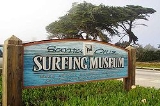
Santa Cruz Surfing Museum
Encyclopedia
The Santa Cruz Surfing Museum is a museum
which was established in May 1986 to document the history of surfing. With collections dating back to the earliest years of surfing on mainland United States
, the museum houses a historical account of surfing in Santa Cruz, California
.
The lighthouse was built in 1967 as a memorial to surfer Mark Abott, who died while surfing at the nearby Pleasure Point
surf break.
Overlooking the Steamer Lane
surfing hotspot, this little museum features photographs, surfboards, and videos tracing over 100 years of surfing history in Santa Cruz.
After funding cuts in 2009, the Santa Cruz Surfing Club Preservation Society and private donations kept the museum open.
and over 100 years of surfing in Santa Cruz. Introduced in 1885 by three Hawaiian princes who surfed the mouth of the San Lorenzo River
on plank boards, surfing has permeated every facet of the Santa Cruz community.
A plaque was dedicated to the princes: David Kawānanakoa
, Edward Keliʻiahonui, and Jonah Kūhiō Kalanianaʻole (later a delegate to US Congress) in April 2010.
Throughout its history, surf culture has reflected and responded to popular culture. Photographs chronicle the evolution of surfing culture in Santa Cruz from idyllic summers spent at the beach in the 1930s and 1940s, through the hipster beach party 1950s, the surf rock 1960s, the “soul surfing” 1970s, the neon 1980s, and the rebirth of classic long-board riding in the 1990s.
Examples of surfboards from each era are on display, from the huge hollow paddle boards and redwood planks made and ridden in the 1930s and 1940s to examples of early foam and fiberglass
boards, and speedy short boards used to create radical new surf moves beginning in the 1970s.
Museum
A museum is an institution that cares for a collection of artifacts and other objects of scientific, artistic, cultural, or historical importance and makes them available for public viewing through exhibits that may be permanent or temporary. Most large museums are located in major cities...
which was established in May 1986 to document the history of surfing. With collections dating back to the earliest years of surfing on mainland United States
United States
The United States of America is a federal constitutional republic comprising fifty states and a federal district...
, the museum houses a historical account of surfing in Santa Cruz, California
Santa Cruz, California
Santa Cruz is the county seat and largest city of Santa Cruz County, California in the US. As of the 2010 U.S. Census, Santa Cruz had a total population of 59,946...
.
Location
Located in the Mark Abbott Memorial Lighthouse at Lighthouse Point on West Cliff Drive, the Santa Cruz Surfing Museum opened its doors in June 1986 as the first surfing museum in the world.The lighthouse was built in 1967 as a memorial to surfer Mark Abott, who died while surfing at the nearby Pleasure Point
Pleasure Point, California
Pleasure Point is a census-designated place in Santa Cruz County, California. Pleasure Point sits at an elevation of . The 2010 United States census reported Pleasure Point's population was 5,846.-Geography:...
surf break.
Overlooking the Steamer Lane
Steamer Lane
Steamer Lane is a famous surfing location in Santa Cruz, California. It is just off a point on the side of cliffs in the West Cliff residential area near downtown Santa Cruz, providing easy access and a good vantage point for viewing. The Santa Cruz Surfing Museum is housed in a lighthouse there....
surfing hotspot, this little museum features photographs, surfboards, and videos tracing over 100 years of surfing history in Santa Cruz.
After funding cuts in 2009, the Santa Cruz Surfing Club Preservation Society and private donations kept the museum open.
Exhibits
The exhibits at the museum explore this unique culture from its early origins in Ancient HawaiiAncient Hawaii
Ancient Hawaii refers to the period of Hawaiian human history preceding the unification of the Kingdom of Hawaii by Kamehameha the Great in 1810. After being first settled by Polynesian long-distance navigators sometime between AD 300–800, a unique culture developed. Diversified agroforestry and...
and over 100 years of surfing in Santa Cruz. Introduced in 1885 by three Hawaiian princes who surfed the mouth of the San Lorenzo River
San Lorenzo River
The San Lorenzo River drains a large watershed in Santa Cruz County, California. The headwaters originate in the Santa Cruz Mountains at an elevation of , and the river flows through the San Lorenzo Valley before emptying into the Pacific Ocean at Monterey Bay...
on plank boards, surfing has permeated every facet of the Santa Cruz community.
A plaque was dedicated to the princes: David Kawānanakoa
David Kawananakoa
Prince David Laamea Kahalepouli Kinoiki Kawānanakoa Piikoi , was the patriarch of the House of Kawānanakoa. He was in the line of succession to the throne of the Kingdom of Hawaii around the time of the kingdom's overthrow.-Life:...
, Edward Keliʻiahonui, and Jonah Kūhiō Kalanianaʻole (later a delegate to US Congress) in April 2010.
Throughout its history, surf culture has reflected and responded to popular culture. Photographs chronicle the evolution of surfing culture in Santa Cruz from idyllic summers spent at the beach in the 1930s and 1940s, through the hipster beach party 1950s, the surf rock 1960s, the “soul surfing” 1970s, the neon 1980s, and the rebirth of classic long-board riding in the 1990s.
Examples of surfboards from each era are on display, from the huge hollow paddle boards and redwood planks made and ridden in the 1930s and 1940s to examples of early foam and fiberglass
Fiberglass
Glass fiber is a material consisting of numerous extremely fine fibers of glass.Glassmakers throughout history have experimented with glass fibers, but mass manufacture of glass fiber was only made possible with the invention of finer machine tooling...
boards, and speedy short boards used to create radical new surf moves beginning in the 1970s.
External links
- Santa Cruz Surfing Museum Website
- Santa Cruz Surfing Museum City of Santa Cruz website

